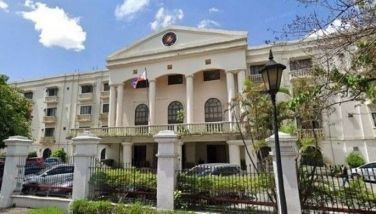Pristine Bagac refuses to host Metro’s garbage
February 19, 2002 | 12:00am
"It is right beside a clear sea, where you can practically scoop up eels, shrimps and snails," she begins, ruminating about the coastal barangay where she was born and where she hopes to die someday. "There are cogon grasslands. There are mango trees, kalamansi shrubs and other fruit-bearing plants. Sometimes, there are stray deer or wild boar."
Sitting in a noisy, crowded restaurant in Metro Manila, about 100 kilometers away from her hometown, which she and fellow Quinaweños left to appeal for help from national authorities, Miraflor says she cannot bear the thought that the paradise she has lived in all her life may soon be replaced by a mountain of rotting garbage, and inevitably, rats and vermin. "Napakasakit isipin," she says.
Last October, Metro Manila Development Authority (MMDA) Chairman Benjamin Abalos announced that President Arroyo had ordered the shipping of Metro Manila’s garbage, already rotting in Vitas, Tondo’s Pier 18, to Bagac, one of 12 towns in Bataan.
Abalos pointed to a resolution approved last March by the barangay council, allowing Waste Management Industries Inc. (WMII) to set up a "recycling plant" in a 300-hectare property in Quinawan.
What he failed to say was that the move violates the provisions of the Ecological Solid Waste Management Act of 2001 (Republic Act 9003), the first law signed by President Arroyo. Worse, the planned site is at the foot of Mt. Mariveles, and right at a pristine spot favored by local and foreign tourists because of its white sand, bird caves and coral reefs.
So abundant in natural resources is the municipality that it has been proclaimed a natural park through Presidential Proclamation 24, or Republic Act 7586, otherwise known as the National Integrated Protected Areas Law.
Bagac, along with the rest of the Bataan Peninsula, is also steeped in history. It is home to many historical landmarks including the Filipino-Japanese Friendship Tower, frequented by Japanese tourists to commemorate relatives who died during World War II; the Zero Kilometer Death March Marker, and the Battle of the Points, at Quinawan. Two Buddhist shrines have been erected in Quinawan, to commemorate the spot where an estimated 3,000 Japanese soldiers died during fierce battles with US and Filipino guerrillas during World War II.
Because of its historical significance, the National Economic Development Authority (NEDA) has identified Bagac as a "very potential tourism hot spot" in its Central Luzon Tourism Master Plan. In 2001 alone, about 107,000 tourists visited various beach resorts in the peninsula.
Quinawan residents, alarmed that they may soon be inundated with Metro Manila’s trash, have formed the Mamamayan Laban sa Basura (MLB), to oppose the recycling plant. According to MLB spokesman Joe Galvez, the barangay resolution bandied about by Abalos had in fact emanated from the municipal government and was approved without public hearings.
"We have no intention of hosting the garbage of any city, or the garbage of the province," says Galvez, a former councilor. "The proposal is an open violation of Republic Act 9003, or the Ecological Solid Waste Management Act (ESWMA), which states that each municipality must have its own eco-waste management facility for the disposal of its own garbage."
The MLB has accused Bataan Gov. Leonardo Roman of having a vested interest in the project. It says Roman’s younger brother, Victor, owns portions of the land. It cited as basis a certification issued last Aug. 14, 2001 by the Provincial Environment and Natural Resources Office (PENRO) officer Ricardo Alarcon, which stated that the landfill site lies in property owned by "Francisco Cortez Sr. et al, Victor Roman et al, and others under Bagac Cadastral 244."
But Alarcon would claim later that Victor Roman was merely "a claimant" based on the latest cadastral survey it conducted. The governor himself has said that local businessman Rolly Roxas is the real owner of the property.
The MLB, however, is likewise questioning WMII’s technical and financial capability to handle the project that is known officially as the "Bataan Ecological Waste Management Complex."
That project, which did not undergo any bidding, failed to materialize after Mariveles residents filed a temporary restraining order saying there was no certificate of willingness to host the facility. Then GSWMC chairman Robert Aventajado had countered that no such thing was needed, and not even an Environmental Compliance Certificate (ECC) was required, because the proposed site was "not protected or watershed areas."
According to industry insiders, however, it would still have been impossible for WAR to operate the Mariveles project, because it could not even afford to buy the land it identified as its potential site, for P5 million. Von Hernandez, campaign director for Greenpeace Southeast Asia, says this was not unusual, since there are many waste companies around the world who misrepresent themselves as big companies. "Kadalasan, laway lang ang puhunan (Often their capital is only saliva)," he says.
WMII director Napoleon Opiniano refused requests for comment and clarification. The company’s Bagac project is still awaiting an ECC.
Waste-management experts note that for projects that do not undergo bidding, such as that in Mariveles and now in Bagac, there are really no guarantees of fiscal as well as environmental integrity.
But they also warn against the misconception that an ECC at least affords such guarantees. After all, the Environment Management Bureau (EMB), which is in charge of recommending the issuance of ECCs to the Department of Environment and Natural Resources (DENR), does not scrutinize a company’s background. It only evaluates the soundness of the proposal, among other things.
A waste-management consultant also points out that an ECC "must be a working document, which means that it will require strict monitoring." Lack of funds, personnel and commitment have not made this possible in nearly all government projects, including the closed landfills in San Mateo, Rizal, and Carmona, Cavite, where the communities have suffered ecological damage, among them the leachate contamination of local water supplies.
Why anyone would want to risk the ecological balance of a place like Bagac, or destroy its tourism potential, is a question that residents and environmentalists alike are asking.
That someone would even think of such a thing was probably beyond Miraflor, a kagawad or member of the barangay council, which is why she had merely taken the word of barangay captain Lorenzo Laguna who said the resolution he wanted her to sign would spell progress for their place. Miraflor now confesses she did not read the resolution, but believed Laguna who said it would enable them to have a new schoolbuilding, a hospital, new roads, "at may spring development pa."
She was later puzzled, she says, when she learned that other kagawad, including her own relatives, recounted having been given money ranging from P3,600 to P5,000. "Suddenly they had new fishing nets," recalls Miraflor. She also says that Laguna himself offered to help pay for the hospitalization expenses of a relative, but that she had declined. A month later, each Quinawan family received a small bag of rice, which Miraflor thought was highly unusual. "There was no reason for it," she says. "There wasn’t any typhoon."
It was only when she read newspaper reports that 15 percent of Metro Manila’s daily 6,000 tons of trash would be brought to her barangay that Miraflor says she finally realized the full import of the resolution that she had signed and the sudden flow of money in Quinawan. Horrified, she joined the MLB.
Health officials had warned early last year that with the garbage crisis unresolved, the country was on the road to having "a health epidemic of uncontrolled proportions." With Pier 19 choking in refuse, unregulated, open dumpsites — where garbage remains exposed – have sprouted nearly everywhere. Residents of Bgy. Veinte Reales, Valenzuela and Bgy. Kaingin, Meycauayan — both in Bulacan — have been complaining of respiratory and other health problems resulting from an open dumpsite near their area.
Garbage operators have also resumed dumping in Payatas, Quezon City, which had been ordered closed by the Estrada administration, shortly after a mountain of garbage collapsed and swallowed hundreds of residents in July 2000.
"We’re not even talking about other forms of garbage yet," points out Hernandez, adding that how government deals with toxic and hazardous wastes has not also been addressed. He also says that with the World Bank estimating that country’s trash output would increase by 40 percent along with the corresponding increase in population by 2010, the prospects for the future are frightening.
The World Bank, in its Philippines Environment Monitor of 2001, stressed that the country’s garbage problem has reached a magnitude that "requires consolidated efforts by the government and citizens."
And while even activists consider the Ecological Solid Waste Management Act to be a step in the right direction, they say it has yet to find real champions among national and local government officials.
In fact, right in the backyard of Mandaluyong, the city run by Benhur Abalos, son of the MMDA chief, compliance of the Act and MMDA Ordinance 99-004 regarding garbage segregation has been "honestly, 10 percent," according to Diosdado Daylo, the man in charge of Garbage Collection at the city’s Clean and Green office.
Daylo blames contractors, saying trucks refuse to make separate trips for recyclable and non-recyclable materials. Daylo says Mandaluyong spends "roughly P2 million" a month for hauling garbage, yet he does not know where they eventually end up. "Wala namang aamin. Lahat sasabihin, ‘secret’ (No one wants to say. All they say is, ‘secret’)," he says.
Daylo also cannot explain why the city is unable to punish erring contractors when the ordinance imposes a penalty and since the city after all controls the purse strings.
MMDA big boss Abalos himself publicly advocates recycling, but he has quietly endorsed the mayors’ demands. In a policy report submitted to the Cabinet last year, he stated, "the garbage problem is attributed to the prohibition on the use of incinerators by the Clean Air Act," along with "the opposition of local communities towards the establishment of open dumpsites in their area."
The government’s dirty secret is that while the RA 9003, in the President’s own words "prohibits the open dumping of solid wastes and the establishment of sanitary landfills for final disposal," the Arroyo administration — through the MMDA and the DENR — has been focused on finding communities that will agree to host dumpsites and landfills.
Abalos’s policy report last year identified at least six big-ticket landfill proposals "endorsed by the DENR" as a "medium to long-term solution" to the garbage crisis.
"Any of the offshore landfill proposals, including one that will reclaim 400 hectares of land in Manila Bay, "will guarantee a garbage-free Metro Manila for the next 15 years," the report said. It makes no mention at all of any plan to set in motion RA 9003, which Mrs. Arroyo had stated in her signing remarks as a "landmark law (that) is expected to significantly reduce the volume of waste residual for final disposal and thus, alleviate the pressures on the capacity of our landfill."
BrandSpace Articles
<
>
- Latest
- Trending
Trending
Latest


























